Simon Guerrier's Blog, page 13
September 12, 2024
Doctor Who Magazine #608
 The new issue of the official Doctor Who Magazine is out today. My regular Script to Screen feature (pp. 26-30) this time covers the slug-like Mantraps seen in Dot and Bubble, for which I interviewed executive producer Joel Collins and production designer Phil Sims.
The new issue of the official Doctor Who Magazine is out today. My regular Script to Screen feature (pp. 26-30) this time covers the slug-like Mantraps seen in Dot and Bubble, for which I interviewed executive producer Joel Collins and production designer Phil Sims.There's also a review of Deathworld, the story I script edited for Big Finish, which Jamie Lenman finds "surprising, and really quite touching". In Galaxy Forum, reader Bill Silver says nice things about the work Gav Rymill, Rhys Williams and I did on recreating the sets of missing episodes in the recent special issue.
And I think Eddie Robson's fun "This month in..." column (p. 49) uses an image of Doctor Who creators Sydney Newman and Donald Wilson that I spotted in an old issue of BBC in-house magazine Ariel, snapped on my phone and then cropped - those are Judi Dench's hands (and wine glass) in the bottom left.
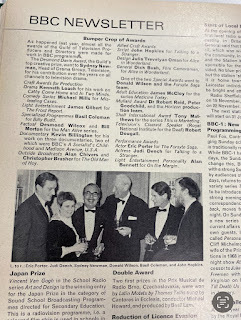 Aerial, December 1967
Aerial, December 1967
September 8, 2024
Garry Halliday and the Sands of Time, by Justin Blake
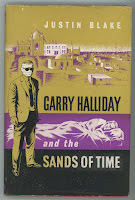 I'm ploughing on with my episode guide to the BBC children's serial Garry Halliday (1959-62), and ahead of an entry there on the fourth of the eight serials, here are some thoughts on the novelisation.
I'm ploughing on with my episode guide to the BBC children's serial Garry Halliday (1959-62), and ahead of an entry there on the fourth of the eight serials, here are some thoughts on the novelisation.At the end of the third Garry Halliday novelisation, airline pilot and adventurer Garry skis down a mountain in Switzerland in time to catch the elusive criminal mastermind known as the Voice, whose own henchpeople have never seen in person. The Voice is sent to prison - and then promptly escapes.
In this next adventure, the Voice aims to deal with the 10 people who clapped eyes on him during his short time as captive, and thus regain his anonymity. The Swiss police inspector, the pilot of the plane who flew the Voice from Switzerland back to London and some prison staff at Pentonville each go missing for a week or so, and then are found with their memories wiped. As Garry, his trusty co-pilot Bill Dodds and their friend Inspector Potter from Scotland Yard investigate, they too face capture and the same sinister process.
This fourth Garry Halliday serial - broadcast over seven weeks between 5 November and 17 December 1960, never repeated but published in book form in October 1963 - taps into a contemporary fear. Brainwash Culture, Daniel Pick's 2016 documentary for Radio 3, is very good on the history of this, in real life and popular culture (and very useful when I wrote my book on 1967 Doctor Who story The Evil of the Daleks).
In short, during the Korean War (1950-53), reports emerged of coercive techniques being used by Maoist forces. This "brainwashing" was cited to explain why western prisoners of war had apparently aided their captors and why 21 American soldiers asked not to be repatriated. Whatever the truth behind these claims, they informed Richard Condon's 1959 novel, The Manchurian Candidate, in which a loyal American soldier undergoes conditioning that makes him commit treason. An acclaimed film version starring Frank Sinatra was released in 1962, the same year that Anthony Burgess' A Clockwork Orange and Len Deighton's The IPCRESS File were published, both exploring the disturbing ways such techniques might be exploited.
We can see similar ideas being explored in such fare as the 1963 film The Mind Benders, the opening of Ian Fleming's 1964 novel, The Man with the Golden Gun (when James Bond is the victim of such techniques!) and lot of early Doctor Who. It's a particularly effective wheeze in TV and film, where we can see the conflict of "good" characters struggling to fight the conditioning.
Garry Halliday was tapping into the zeitgeist and was perhaps even a bit ahead of the game. But it's odd that the characters we see brainwashed are mostly those we don't otherwise know - the Swiss inspector and prison staff. Inspector Potter, who is also subjected to the technique, featured in the previous serial but played by a different actor, which may have lessened the impact of seeing him "turned" to work for the villains. At one point, Garry Halliday succumbs to the drugged water that begins the brainwashing process but we don't see him act out of character. Bill Dodds is also unaffected. It felt to me a though an obvious bit of drama had been missed.
Then there's the sense of the novelisation patching over holes in the storyline, for example why the Voice can only be recognised by the few people who saw him, rather than from a mug shot when he was arrested.
"What records there were of him had disappeared. There was one newspaper photograph. Even the Voice couldn't get rid of every copy of a newspaper with a circulation of four and a half million. The newspaper picture was blurred and grey on bad paper. It showed a bulky man with an arm over his face. Such as it was, it had been circulated to the police of every country in the world. Most of those to whom if had been circulated had replied, more or les politely, that it seemed useless as a means of identification." (p. 19)
The not quite stated implication is that he has people in the police and in newsrooms who have disposed of the original photographs. The irony, of course, is that very little in the way of visual or written records survive related to Garry Halliday.
That makes it difficult to grasp exactly what this serial would have looked and felt like on screen. As on previous serials, the location filming featured in publicity. In the story, the Voice is working from the fictional state of Balakesh, a short distance from real-life Tripoli. Producer Richard West says in his memoir The Reluctant Soldier & Greasepaint and Girls that he, co-writer Jeremy Bullmore, lead actor Terence Longdon, cameraman Tony Good and West's assistant (which may have been Jean Hart) flew out to Tripoli to film picturesque shots on location, without any idea what the story would entail. The plot would be devised around whatever they shot.
In fact, West says, not having prior permission to film outside the American-run Wheelus Air Base, they were all arrested. On another occasion, locals interrupted filming by throwing rocks. The suggestion is that the guerrilla crew didn't get as much footage as they'd have liked and these frustrations may have coloured the way the Balakesh was depicted.
There had been criticism of previous Garry Halliday serials for stereotypical depictions of silly foreigners. The Arabs here are by turns parochial, corrupt and greedy. Bill Dodds at one point adopts a disguise, half naked and blacked up. The novelisation tells us, not very convincingly, that this was,
"not in the hope of being taken for an Arab but simply so as to make it more difficult for anyone to see him" (p. 105).
Halliday expresses horror at the death penalty being used in Balakesh, though capital punishment wasn't abolished in the UK until 1965 (and not until 2000 for all circumstances). But I think the harshness of the regime is all set-up for the end of the story. The Sheikh allows the Voice to escape into the desert, which is effectively a death sentence. The Voice is last seen wandering lost in the sand with nothing to drink.
There's no mention in the surviving sources that actor Elwyn Brook-Jones was part of the crew out in Tripoli, so I wonder how this haunting scene was conveyed on screen. As with the ski chase at the end of the previous serial, it has the potential for arresting visuals if filmed out on location, and for something much less exciting if realised in studio.
On TV, this wasn't the end of the Voice. Yet by the time the book was published, Brook-Jones was dead and Garry Halliday was no longer being made or repeated. The authors therefore tell us in a foreword that this is the last of Halliday's encounters with the Voice and provide some background to the character. They say this is what Halliday subsequently learned - suggesting that this information was not given in the TV version.
This serial was also the last to feature Bill Dodds and his fiancee Sonya, played by Terence Alexander and his wife Juno Stevas. Sonya has relatively little to do in the story, and based on the novelisation it doesn't look as though the couple were involved in location filming. Oddly, whereas the previous three novelisations were narrated by Dodds, here the story is told in the third person. We're told Bill and Sonya are now happily,
"settled down to domestic life and two kids (at the present count)" (p. 11)
But I wonder how happy things really were as the actors left the series.
September 5, 2024
Don't Stop the Music, by Justin Lewis
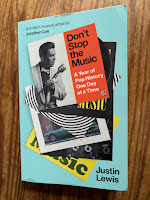 By fun coincidence, I received a copy of this book - recommended to me by various friends since publication last year - two days after happening to meet its author. By another fun coincidence, I've finally read it having just read Question 7 by Richard Flanagan, which explores the idea of the past and present all happening at once. In Don't Stop the Music, the idea is more, I think, that there's an overlapping past.
By fun coincidence, I received a copy of this book - recommended to me by various friends since publication last year - two days after happening to meet its author. By another fun coincidence, I've finally read it having just read Question 7 by Richard Flanagan, which explores the idea of the past and present all happening at once. In Don't Stop the Music, the idea is more, I think, that there's an overlapping past.This is basically a sort of toilet book full of odd bits of pop music history. But the organising principle lifts it into something else. Lewis provides facts for each calendar day of the year, in chronological order. In the very first entry, we learn that on 1 January 1958 Johnny Cash plays his first concert at San Quentin State Prison in California, where future country-and-western singer Merle Haggard is one of the captive audience (the author's pun). On the same day in 1962, the Beatles record five songs for Decca Records, who turn them down. On the same day two years later, the Beatles are at #1 with 'I Want to Hold Your Hand' and the first edition of Top of the Pops is broadcast on the BBC (featuring Dusty Springfield, the Rolling Stones and the Hollies). On the same day in 1990, Florida radio station WKRL plays 'Stairway to Heaven' by Led Zeppelin - and continues to repeat it non-stop for 24 hours.
Note the present tense of all this: these bits of history are still happening now, a sense reinforced by the fact that we can hear the music. In fact, I read this with my phone handy to look up tracks on iTunes - stuff I'd not heard in a while, stuff that was wholly new.
Also, note the range in just this first entry: pop and rock and country, reaching right back to the birth of rock n' roll - and beyond. Other entries bring us up to date, or at least to time of publication. There's also a diversity of entry: some funny, some weird and some poignant.
There's plenty here I didn't know, for example that the launch of Sputnik 2 in October 1957 was timed to coincide with the International Geophysical Year involving 67 different countries. I knew about the IGY from when, more than a decade ago, the Dr worked on a BBC archive project which put old clips and programmes online. One thing she and her team dug out was The Restless Sphere, a programme presented by the Duke of Edinburgh - live - giving an overview of all the work planned. I'd not made the connection between that and the space programme, and I learn from Lewis that the IGY was also commemorated in 1982, in the opening track of Donald Fagen's first solo album after leaving Steely Dan, Fagen looking back to the promise of a future that should have been the then-now.
The book is full of these kinds of connections and juxtapositions. One song or event influences another, or the backing singing of one band then has their own entry as a star. These connections are the point; in the introduction Lewis says the lack of an index is a creative decision as he wanted to ensure the book is "a little more than a dipping-in exercise." What I'd really like instead is a map.
By another fun coincidence, I've used a similar organising principle for Doctor Who: The Time-Travelling Almanac, which is out next month. My hope there was to conjure a sense of the year as physical journey as we go round and round the Sun, so the anniversary of any particular date is us returning to the same spot. In my book, that then sparks other thoughts and peregrinations, some of them much longer than the entries here. It's a different kind of journey, I think, but starting from a similar place.
September 1, 2024
Question 7, by Richard Flanagan
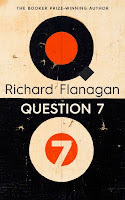 Richard Flanagan won the Booker Prize in 2014 for his novel The Narrow Road to the Deep North, which was in part based on his father's experience as a prisoner of war in Japan. He's also the author of Death of River Guide (1994), in part based on the author's own experience of a near-fatal accident while out on a kayak.
Richard Flanagan won the Booker Prize in 2014 for his novel The Narrow Road to the Deep North, which was in part based on his father's experience as a prisoner of war in Japan. He's also the author of Death of River Guide (1994), in part based on the author's own experience of a near-fatal accident while out on a kayak.This new book is non-fiction but revisits the real events behind these two novels, connecting them to - among other things - the history of Flanagan's native Tasmania, the invention of the nuclear bomb and the love life of HG Wells and Rebecca West. It's about the way reality informs fiction and fiction informs reality, and the way the past is present in the now. It's a remarkable, rich and vivid flit through all sorts of bits of history, at once directly, movingly personal and yet about us all.
Flanagan cites in his acknowledgements one key influence: the essay ‘The past is in the present is in the future’ by 18 year-old Sienna Stubbs, which describes her Yolŋu culture's understanding of a fourth tense, beyond past, present and future, in which what was and is and will be are all happening at once. So, all these years later after the real event, Flanagan is still 21 and trapped in his kayak, facing imminent death. And HG is still snogging the teenage Rebecca West. And the bomb is still being dropped on Horoshima.
Some of the history here I've already dug into, having made a Radio 4 documentary about how HG Well's novel The World Set Free, in which he coined the term "atomic bomb", inspired Hungarian physicist Leo Szilard to conceive the chain reaction component that would make such a thing a reality; but the Wells book also made him realise the terrible consequence of such a device used on an urban population. We seem to have worked from several of the same sources, and I'm glad to see that Flanagan, likewise, sees Szilard as both a pivotal and fascinating figure (whereas he makes a single, fleeting appearance in the film Oppenheimer).
Flanagan delves further than we did in our documentary (where we had just 42 minutes, and covered some other ground) to explore the circumstances in which Wells wrote The Wells Set Free and the women he was involved with at the time, as well as pursuing what happened to Szilard and addressing his own efforts to write science-fiction. I've got a copy of Szilard's book on its way and will report back in due course.
So it's a fascinating story being covered here, and yet also beautifully, succinctly told in short bursts that make it difficult to put down when you could just do one more short section. Yet it's also often viscerally shocking, whether detailing the impact of the bomb on Hiroshima or the genocide in Tasmania, or the denouement in which he recounts in detail his experience on the river. Also shocking is his meeting the men who held his father captor, asking one old man to hit slap him in the way he'd slapped the prisoners in his charge. Or there's the racism, sexism and cultural condescension faced while a student at Oxford (p. 231), and then this:
"Meanwhile, the Bullers wandered the Oxford streets, dressed absurdly as themselves or offensively as Nazis and after dinner had the whores in. The Buller B—who would be prime minister wanted me to be his wingman when he ran a second time for Oxford Union president, one more whore. I told him I couldn't stand the Union, that I wasn't a member, and why, in any case, would I bother? B— said when I ran he would help me if I helped him and so I repeated my original answer and B— fif-faf-fuddled because he really had no answer, no one did, he was charming and you couldn't believe a thing he said..." (pp. 233-4)
August 24, 2024
The DNA of Doctor Who - The Philip Hinchcliffe Years
 I've just received my copy of this handsome new book, to which I contributed an essay on the 1975 Doctor Who story Planet of Evil and what it draws from classic works of science-fiction.
I've just received my copy of this handsome new book, to which I contributed an essay on the 1975 Doctor Who story Planet of Evil and what it draws from classic works of science-fiction.The obvious influence, of course, is the 1956 movie Forbidden Planet, which the BBC broadcast at 6.35 pm on Wednesday 6 November 1974 - just right to inspire the development of the Doctor Who stories that became Planet of Evil and The Brain of Morbius. I dig into that and also how the same film influenced early Doctor Who as well as other sci-fi such as Star Trek (citing the excellent ‘Gene Roddenberry’s Cinematic Influences’ by Michael Kmet from 2013) and Star Wars (see the 2012 Wired interview, ‘Ben Burtt on Star Wars, Forbidden Planet and the Sound of Sci-Fi’ y Geeta Dayal).
Hinchcliffe says on the documentary made for the DVD release of Planet of Evil (by my friend Ed Stradling) that he suggested the ‘flying eye’ drone seen in the story, having read of something similar in a science-fiction story at the time. The Dictionary of Surveillance Terms in Science Fiction at the Technovelgy site helped me suggest some candidates for that story.
I also mention Isaac Asimov’s own timeline-of-the-future for his various short stories and novels, which I drew from ‘A page from Isaac Asimov’s notebook’, Thrilling Wonder Stories, vol. 44 #3 (Winter 1955), p. 63.
Edited by Gary Russell and published by Gareth Kavanagh at Roundel Books, you can buy The DNA of Doctor Who - The Philip Hinchcliffe Years from the Cutaway Comics site.
August 22, 2024
Garry Halliday episode guide
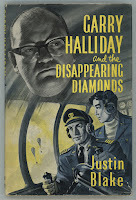 I've posted the first two entries in what I hope will be an exhaustive guide to Garry Halliday, a BBC serial about the adventures of an airline pilot created by Justin Blake (i.e. John Bowen and Jeremy Bullmore), that ran between 1959 and 1962.
I've posted the first two entries in what I hope will be an exhaustive guide to Garry Halliday, a BBC serial about the adventures of an airline pilot created by Justin Blake (i.e. John Bowen and Jeremy Bullmore), that ran between 1959 and 1962.The BBC made 50 episodes, only one of which survives. But Doctor Who was devised to fill the same Saturday teatime slot and I think owes a significant amount to Halliday, which I'll tease out as I go through the history.
As with Doctor Who, there were novelisations of Garry Halliday's TV adventures. I now have copies of all five Garry Halliday books, and have already posted reviews here of the first three of them:
Garry Halliday and the Disappearing Diamonds (1960)Garry Halliday and the Ray of Death (1961)Garry Halliday and the Kidnapped Five (1962)August 21, 2024
Slow Horses, by Mick Herron
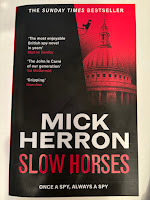 River Cartwright is a nepo baby in MI5, his grandfather a retired top spook. But River cocks up a big operation and, in disgrace, is assigned to Slough House with all the other service failures — the so-called "slow horses". There, he's given such menial jobs as listing the contents of a journalist's rubbish bin... But then a young man is kidnapped by extremists and the slow horses might be his only hope of surviving.
River Cartwright is a nepo baby in MI5, his grandfather a retired top spook. But River cocks up a big operation and, in disgrace, is assigned to Slough House with all the other service failures — the so-called "slow horses". There, he's given such menial jobs as listing the contents of a journalist's rubbish bin... But then a young man is kidnapped by extremists and the slow horses might be his only hope of surviving.The TV version sticks closely to this thrilling, dour and often funny spy caper so I knew pretty much what was coming. A few things are different just because the book is set around the time of publication in 2010, in the shadow of the then-recent 7/7 bombings in London.
That made me think about the context of the references to real people, such as Russell T Davies being named in a newspaper masthead (p. 28) — presumably in a story about what he was up to immediately post-Doctor Who. On another occasion, we're told that the head of Slough House, Jackson Lamb, resembles and could be played by Timothy Spall (p. 32), which is jarring now Lamb has been brought so soddenly to life by Gary Oldman.
These references add verisimilitude to the grubby, kitchen-sink reality. But that only makes it all the odder when Herron draws so closely from a real person to describe a fictional cabinet minister:
"Peter Judd. PJ to his friends, and everyone else. Fluffy-hair and youthful at forty-eight, and with a vocabulary peppered with archaic expostulations — Balderdash! Tommy-rot!! Oh my giddy aunt!!! — Peter Judd had long established himself as the unthreatening face of the old-school right, popular enough with the Great British Public, which though him an amiable idiot, to make a second living outside Parliament as a rent-a-quote-media-whore-cum-quiz-show-panel-favourite, and to get away with minor peccadilloes like dicking his kids' nanny, robbing the taxman blind, and giving his party leader conniptions with off-script flourishes. ('Damn fine city,' he'd remarked on a trip to Paris. 'Probably worth defending next time.') Not everyone who'd worked with him thought him a total buffoon, and some who'd witnessed him lose his temper suspected him of political savvy, but by and large PJ seemed happy with the image he'd either fostered or been born with: a loose cannon with a floppy haircut and a bicycle." (p. 187)This amiable bungler — played by Sam West on TV — turns out to be more right wing and ruthless than he first appears. He's ambitious, too, with his eye on further power. Well, we've been there, done that now.
There are a lot of machinations here, the security service riven with people plotting and counterplotting, betraying their friends to further their own careers or to cover their behinds. Management and "joes" learn to apply one of two protocols to any given situation:
"Moscow rules meant watch your back, London rules meant cover your arse." (pp. 253-254)Here, London rules are most in play. In fact, save for the kidnapping in Leeds, River visiting his grandfather just outside Tonbridge and a sequence in Epping Forest, this is all set in London. Like le Carre, the focus is on activity here, carried out by our people, rather than external antagonists. There's something of The Sandbaggers about the whole thing, too: a focus on spycraft as office job that makes it suit a TV budget.
Some small things are different from the TV version, such as details in prose being rendered in dialogue on screen. The TV version includes flashbacks to elucidate Catherine Standish's past but doesn't show us River Cartwright's childhood or some of the other history shared with us in the book. The kidnapped young man is, on TV, held in a house on an anonymous street; in the book it's the more definite Roupell Street near Waterloo, a place I know very well having once worked just round the corner. (And, er, from the Dalek battle there, too.)
But more than anything, knowing the TV version made me conscious of how frequently Herron uses ploys to hold our attention. There are continual cliffhangers, sometimes contrived by telling events out of chronological order, withholding bits of information or suggesting that one thing has happened then — a few pages later — revealing something else. In some cases, these ploys wouldn't work on TV where we can see what's happening, such as when Herron delays telling us the gender or ethnicity of particular characters, then makes that a surprise.
These methods make for a compelling read, though much of the trick here depends on the reader not knowing what will happen next. I wish I'd read this before I saw the TV version and need to hurry up reading the next ones in the series so I can get to later books unspoiled.
August 15, 2024
The Hobbit, by JJR Tolkien
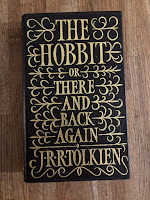 Last night, I finished reading this to Lady Vader, having read it to the Lord of Chaos about five years ago and having had it read to me by my late dad when I was of a similar age. I've read this book countless times, have seen the films and various versions on stage. This is the first time I've read the coo-posh Folio edition that my dad gave me and the Dr long ago one Christmas, illustrated by Eric Fraser. That was a kingly gift!
Last night, I finished reading this to Lady Vader, having read it to the Lord of Chaos about five years ago and having had it read to me by my late dad when I was of a similar age. I've read this book countless times, have seen the films and various versions on stage. This is the first time I've read the coo-posh Folio edition that my dad gave me and the Dr long ago one Christmas, illustrated by Eric Fraser. That was a kingly gift!A few things strike me this time round. First, the number of times that Bilbo Baggins is referred to as "queer", Tolkien of course meaning strange or eccentric. I don't think I've ever seen a reading of Bilbo as gay but that there's various bits of circumstantial evidence here and The Lords of the Rings to support it. That in turn informs a story about close male friendships, through thick and thin.
The older I get, the more fascinated I am by Gandalf, this benign, wise figure trying to sort out a hundred different bits of shit all at once. Having never had much interested in the expanded lore, this time I hung on all the little hints about what Gandalf gets up to after leaving Bilbo and the dwarves at Milkwood, and goes off to deal with a Necromancer. I now know from the film versions of The Hobbit what that's alluding to, which had always past me by before. If I ever have a spare moment - not likely, mate - I'd like to know more about what Tolkien wrote about that and exactly when, given his revisions to the first edition of The Hobbit to better fit its sequels.
I was conscious, too, this time of the voice of Gandalf, which I so associate with my dad's reading and then, in respectable second place, Ian McKellen. Reading The Hobbit this time, I was also struck by the difficulty of distinguishing voices - the gruff-voiced dwarves, with the especially gruff-voiced Thorin, as distinct from gruff Beorn or gruff Bard or gruff Smaug. But on the whole this is a story that really works read aloud. The only thing, I think, that benefits from seeing the words on the page is all the riddling with Golem. There, for the reader to play along, it helps to pick back over the words as one might scrutinise the clues in a crossword.
But whereas The Lords of the Rings is about a fellowship of disparate characters, all very different and distinct, the main cast of The Hobbit is harder to distinguish.
August 10, 2024
The Wine-Dark Sea, by Robert Aickman
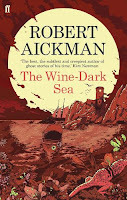 First published in 2014, this is a collection of eight longish short stories — each comprising more than 50 pages. It’s the first Aickman I’ve read, after lots of recommendations. And days after finishing this collection, I’m still trying to make sense of what I might think of it all.
First published in 2014, this is a collection of eight longish short stories — each comprising more than 50 pages. It’s the first Aickman I’ve read, after lots of recommendations. And days after finishing this collection, I’m still trying to make sense of what I might think of it all.In titular story “The Wine-Dark Sea”, an Englishman called Grigg is on holiday in Greece, where he becomes intrigued by a small island that the locals say is off limits. Grigg steals a boat to see the place for himself, and there falls under the spell of three women, a modern take on sirens.
I’d been expecting something in the vein of MR James, and there’s a similar slowly dawning disquiet. But Aickman’s protagonists are ordinary, relatable people rather than James’ bookish academics. There’s also a strong sexual element, very unlike James. In “The Wine-Dark Sea”, Grigg has sex with these sirens; in other stories here, the sexuality is less certain — we’re not always sure if characters are being predatory, or if actions speak of deep-felt desire. But part of the effect is that we’re put on our guard.
That’s a big element of “The Trains”, in which two young woman, Margaret and Mimi, are out rambling and get caught in a storm. They seek shelter in a strange old house overlooking a railway line, and find it a museum to the construction of that same railway. Mimi is enchanted by the owner of the house, Wendley Roper, but Margaret is more sceptical. And yet Mimi is scandalised and Margaret more matter of fact when Roper’s “tall, muscular” servant, a gothic figure called Beech, walks in them while they’re getting changed and Margaret is “absurdly naked”. Was it an accident? As the story progresses, there’s an every growing sense of threat.
In “Your Tiny Hand is Frozen”, lonely Edmund St Jude (landline) phone keeps ringing. Initially, he hears, odd ghostly voices or gets people trying to reach a particular business. And then he strikes up a friendship with a woman who seems keen to reach him in person… This reminded me a lot of Nigel Kneale’s 1952 radio play “You Must Listen”, which I saw a live performance of last year. Both are supernatural stories about technology that was then cutting edge and which people all had in their homes; an encroachment of the strange into the very familiar and everyday.
The best of the bunch here, I think, is “Growing Boys”, about a mild-mannered middle-class woman, Millie, whose sons are fast becoming something monstrous, though their school won’t spell out exactly why they’re being expelled. It’s a comedy of manners and yet brilliantly disturbing.
At one point, Millie tries (again) to talk to her husband Phineas, but he’s too caught up in his own aspirations to stand as a Liberal. Besides, he’s also teetotal.
“If only one could give him a proper drink before one attempted to talk seriously with him; that is, to talk about oneself.
‘It’s the boys, Phineas. You don’t know what it’s like being at home with them all day.’
‘The holidays won’t last for ever.’
‘After only a week, I’m almost insane.’ She tried to rivet his attention. ‘I mean it, Phineas.’
Millie knew extremely well that she herself would be far more eloquent and convincing if Phineas’s absence had not years ago deprived her too, though with never the hint of an express prohibition, but rather the contrary. When she was reading, she had learned of the Saxons never taking action unless the matter had been considered by the council, first when sober and then when drunk. It was the approach that was needed now.
‘What’s the matter with the boys this time?’ asked Phineas.
Millie twitched. ‘They’re far too tall and big. How long is it since you looked at them, Phineas?’
‘Being tall’s hardly their fault. I’m tall myself and I’m their father.’
‘You’re tall in a different way. You’re willowy. They’re like two great red bulls in the house.’
‘I’m afraid we have to look at your family for that aspect of it. Consider your Uncle Nero, if I may venture to mention him.’” (pp. 153-154)
We get here Millie’s despair, hints of the monstrosity of her sons which we then conjure for ourselves, and the way Phineas undermines her — and puts the blame on her, too. Later, when Millie moves in with her Uncle Stephen, he carries her to bed and then, later, welcomes her into his own bed where he can “look after” and “protect” her (p. 192). The sense is of something more brooding and sexual going on, another monstrous something in the family. What’s more, when Millie consults a psychic, she spots other women she knows seeking their own advice — as if the whole community is beset with unsettling strangeness.
In “The Fetch” a man is haunted by a ghostly spectre who carries off his loved ones. Again, the story is as much about the man’s strange marriage to a friend’s ex-wife, and her relationship with her maid, with hints of something sapphic.
“The Inner Room” is about a doll’s house that turns out to have a peculiar real-life counterpart. “Never Visit Venice” sees a traveller give himself up to the spectres of the city. And then there’s “Into the Wood”, about an English woman whose husband is employed to work on road construction in Sweden. While he is busy in this boring line of work, she checks herself into a beguiling hotel, which turns out to be a sanatorium for people who cannot sleep. At first, she seems unaffected… But the title is not about what happens to Margaret Sawyer, but what she will have to do next, beyond the end of the story as told.
Some stories here end decisively, revealing exactly what’s been going on. Others end more opaquely, leaving us to puzzle out their prospective meanings. They’re all very odd, the main thread of plot peppered with other strangeness in passing. And yet they’re also grounded in real details. Aickman is clearly well-read, the stories full of specific detail.
“[‘Orm’ meaning ‘serpent’] was one of the few Swedish words Margaret felt more or less able to manage. The high tessitura in which the language is spoken, the combination of breath and altitude in the vowel sounds, were quite beyond her.” (pp. 375-376)
Or there’s Margaret Sawyers ’s reference to her own Manchester home in the “Cheshire subtopia” (p. 378). That last word is the coinage of Ian Nairn, railing against the nightmare of post-war British architecture, where all urban space looked the same so you could might never know where you were. I think that’s what makes these stories so effective. Aickman isn’t so much adding new strangeness into the recognisable, everyday world; he’s teasing out and showing us what’s already there.
See also: me on Dark Tales by Shirley Jackson
August 9, 2024
David Whitaker postscript / Terry Nation party
You can now download for free the four-page postscript to my biography of David Whitaker, detailing some of the things I've learned since the book was published last November.
The postscript is included in The Who Shop's exclusive paperback editions of the book, and will be added to future versions of the standard paperback at some point.
To accompany the release of the postscript yesterday, I posted a thread to both X (formerly Twitter) and BluSky, and here it is in full:
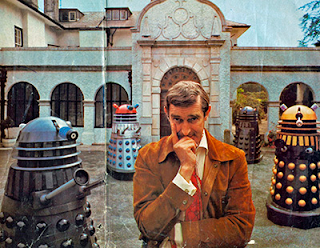 Terry Nation and pals at Lynsted Park, source
Terry Nation and pals at Lynsted Park, sourceWriter and Dalek creator Terry Nation was born on 8 August 1930. OTD in 1964, he hosted a big birthday party at his newly acquired home, Lynsted Park — an Elizabethan mansion in Kent.
You can watch footage of Nation interviewed at home by Alan Whicker in 1967 on the BBC website. But my interest is in that party.
This party haunts my imagination, symbolic of Nation becoming a big showbiz success story after years of toil in light entertainment.
But, like most of these things, the more I’ve looked into it, the richer and stranger the story gets.
I wonder about the logistics. Did Nation provide everyone’s drinks? Was good laid on as well? Given Lynsted Park was quite remote, was there a lot of drink-driving back to London?
But also, who was at this party? While in the Doctor Who production office, Nation sent an invite to actress Carole Ann Ford. (The office kept a copy: Nation to Ford, 31 July 1963, WAC T5/648/2 General)
Nation was at the time hard at work writing The Dalek Invasion of Earth, the serial that would see Ford leave Doctor Who after a year playing the Doctor’s granddaughter Susan.
On the DVD / Blu-ray commentary for The End of Tomorrow (the fourth episode of The Dalek Invasion of Earth), Ford and her colleagues recall Nation’s lavish birthday bash.
In fact, Ford remembered that Nation’s grand new house was in a bit of a state. In particular, she recalled that the swimming pool couldn’t be used; it was full of rubbish.
Co-star William Russell said Nation told him that he hadn’t bought the house because he was suddenly rich from inventing the Daleks (whose debut story had concluded earlier that year).
Instead, Nation said he’d taken out an ‘enormous mortgage’ as a spur to keep busy writing. It was a means to success, rather than a marker of success having been accomplished.
Who else was at the party? Given that Ford and Russell were there, Nation probably invited Doctor Who’s other stars — William Hartnell and Jacqueline Hill.
Hill’s husband Alvin Rakoff told me he remembered going to Lynsted Park but wasn’t sure if it was for this particular party.
Producer Verity Lambert also remembered being at the party, according to the DVD/Blu-ray commentary.
Nation’s invitation to Ford said story editor David Whitaker could help her find the house, implying Whitaker was there, too.
At the time, Whitaker was working with Nation on the new Dalek TV story. They were also co-writing The Dalek Book for publication in September. (And Whitaker was novelising the first Dalek TV story.)
Given all these Doctor Who luminaries at the party, they surely tuned in to watch that evening’s episode — the first instalment of The Reign of Terror by Dennis Spooner.
(To this, my esteemed publisher Stuart Manning added: "Hazel Peiser, the partner of would-be Doctor Who Meets Scratchman director James Hill, recalls attending a party at Nation's mansion where the guests watched Doctor Who go out on TV. James was working on The Saint around that time, so it probably checks out.")
Spooner shared an agent with Nation, who’d recommended him to Whitaker. Two days before the party, it was confirmed that Spooner would join the BBC staff to shadow then succeed Whitaker.
The chances are that Spooner was at the party, too. In his biography of Nation, Alwyn Turner says Roger Moore also attended *one of* Nation’s parties at Lynsted Park, wearing a blue jumpsuit.
I like to imagine them all there together: the current Doctor Who, the future James Bond plus Jackie Hill — who was responsible for Sean Connery’s first big break. For more on the latter, see my post on I’m Just the Guy Who Says Action, by Alvin Rakoff.
At the time of the party, Moore was the star of The Saint, for which Nation wrote (for higher fees than Doctor Who). A week after the party, Whitaker met Saint script supervisor Harry Junkin.
A week later, Whitaker met with Leslie Charteris, creator of The Saint, to discuss a potential musical. Nothing came of these meetings but they were surely instigated by or through Nation.
(Whitaker refers to both meetings in letter to his new agent, Beryl Vertue, at Associated London Scripts, on 14 August 1964, a copy held in Doctor Who production file WAC T5/648/2 General)
In throwing the party and in putting Whitaker and Spooner up for potential jobs, Nation was sharing his largesse. He could afford to be generous — couldn’t he?
As I imagine that party, I wonder what was going through Nation’s mind and how much he felt able to enjoy it himself. He’d certainly had a good few months since the debut of the Daleks.
‘The Daleks have transformed Mr Nation’s life,’ reported Andrew Duncan in Women’s Mirror just over a year later on 30 October 1965, ‘and he could eventually make £1 million from them.’ (NB, he hadn’t yet.)
Then Duncan quoted Nation’s own insecurities about this success. ‘I’ve got this enormous fear that one day a man is going to come and take back all the money.’
Simon Guerrier's Blog
- Simon Guerrier's profile
- 60 followers



